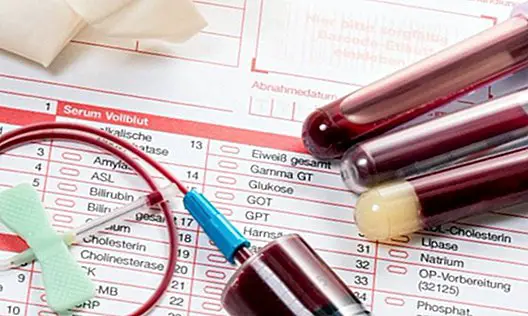The bilirubin in urine
Index
- Direct bilirubin (conjugated)
- Indirect bilirubin (free, unconjugated)
- Normal values
- Analysis of bilirubin in urine
- Low bilirubin
- Why does it increase
- How to lower bilirubin
- Bilirubin in pregnancy
As we explained in a previous article, in which we answered the question what is bilirubin, is characterized by being a yellowish pigment found in the bile (liquid produced and secreted by the liver, and stored in the gallbladder, which helps in the digestion and decomposition of fats in fatty acids).
The analysis of bilirubin In blood it is mainly carried out to know the blood bilirubin values, so that when there is a high value it is more usual that a condition known as jaundice appears (yellowing of the skin, mucous membranes and / or eyes), in addition to being an indicator of malfunction of the liver or gallbladder.

Since it is a useful parameter to know if there may be liver or gallbladder problems, the most common is that it is routinely included in the blood test that we usually perform every so often.
In addition to the bilirubin analysis in the blood, the Urine bilirubin test, about which we speak to you on this occasion.
What is bilirubin?
We could define bilirubin as a product of our body when aged red blood cells break down. It is, therefore, a completely normal and perfectly healthy process.
After these aged red blood cells break down they tend to circulate in the blood until they go to the liver, where it is eliminated through the bile ducts and is stored in the gallbladder. Then the bilirubin is released into the small intestine in the form of bile in order to digest fats. And, finally, it is eliminated through the feces.
What is the analysis of bilirubin in urine?
As its name indicates, The analysis of bilirubin in urine allows to analyze and discover if there are bilirubin pigments in this liquid of natural waste of the organism, so that the most normal thing is that no bilirubin pigments are found in it. That is to say, bilirubin is not normally found in urine.
It is normal for your doctor to tell you to stop taking any drug or medication, as it may affect the test. The most common are: diuretics, steroids, sulfonamides, contraceptive pills, barbiturates, allopurinol, chlorpromazine, indomethacin, ascorbic acid and phenazopyridine.
What is the purpose of bilirubin analysis in urine?
As indicated above, it is a recommended analysis that is carried out routinely when we perform a general blood and urine test.
Considering that bilirubin is not normally found in urine, there is no doubt that a finding of this pigment in the urine is indicative of liver or gallbladder disease.

How is the analysis performed?
The analysis of bilirubin in the urine It is very simple. In fact, the most common is that this parameter is analyzed when performing the study of other urine parameters, when we perform a blood and urine analysis.
Just pee inside a container, discarding the first part of the urine and the last. Then, this urine will be analyzed with a test strip in the laboratory, which will offer an approximate result.
Bilirubin in positive urine
Since the presence of bilirubin in the urine is not normal, when it is found it can be an indication of different disorders and diseases, such as:
- Liver diseases: fatty liver, hepatitis, liver disease, cirrhosis and tumors in the liver.
- Diseases of the gallbladder: bile duct disease, gallstones, gallbladder tumors, or obstruction of the bile ducts.
- Diseases of the pancreas:as for example is the case of pancreatitis.
Bilirubin in urine with false positive
However, we must keep in mind that sometimes bilirubin can be found in the urine without any pathology. In these cases, it is a completely casual and nonspecific finding, especially when there is no symptomatology related to any other disease that causes this presence.
In fact, when there is no associated pathology, the most usual thing is that it is due to dehydration or when the person has been many hours without drinking liquids.
Therefore, when bilirubin is found in the urine, it is more common for this analysis to be repeated, to assess whether it has been a casual and effectively nonspecific positive.

How to lower bilirubin in the urine?
It is customary for the doctor to find bilirubin in the urine after a new analysis in about 3 months, and if he or she is found again, he will prescribe other routine tests.
Therefore, the high bilirubin in urine can only be eliminated and reduced when the cause that has caused its appearance in this waste liquid is identified.
However, it is advisable to follow the health tips that we recommend below:
- Avoid alcohol consumption, one of the biggest enemies of the liver.
- Follow a healthy and healthy diet, eliminating from your diet or reducing the consumption of sausages, red and white meats, processed foods, fried foods, dairy products and derivatives.
- Opt for liver tonics such as dandelion, artichoke, milk thistle, verbena and wild yam.
- Drink between 1.5 and 2 liters of water every day. Also opt for infusions, teas and tisanes.
We also recommend:
What is bilirubin? / Normal Values of Bilirubin / Hepatic Steatosis This article is published for informational purposes only. It can not and should not replace the consultation with a Physician. We advise you to consult your Trusted Doctor.



